|
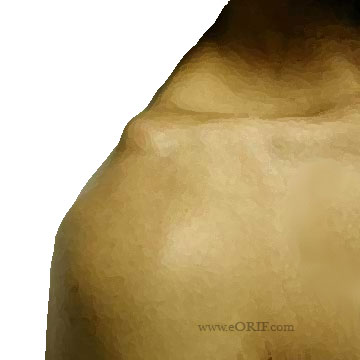
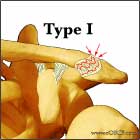
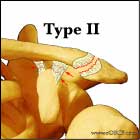
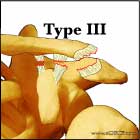
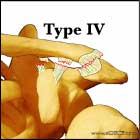

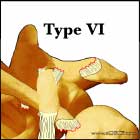
|
synonyms:
AC Separation ICD-10
- S43.109 (A,D,S)- Unspecified dislocation of unspecified acromioclavicular joint
- S43.111(A,D,S) - Subluxation of right acromioclavicular joint
- S43.112(A,D,S) - Subluxation of left acromioclavicular joint, initial encounter
- S43.121(A,D,S) - Dislocation of right acromioclavicular joint, 100%-200% displacement
- S43.122(A,D,S) - Dislocation of left acromioclavicular joint, 100%-200% displacement
- S43.131 (A,D,S)- Dislocation of right acromioclavicular joint, greater than 200% displacementa
- S43.132 (A,D,S)- Dislocation of left acromioclavicular joint, greater than 200% displacement
- S43.141(A,D,S) - Inferior dislocation of right acromioclavicular joint
- S43.142 (A,D,S)- Inferior dislocation of left acromioclavicular joint
- S43.151 (A,D,S) - Posterior dislocation of right acromioclavicular joint
- S43.152 (A,D,S) - Posterior dislocation of left acromioclavicular joint
- A=initial encounter, D=subsequent encounter, S=sequela
AC Separation ICD-9
- 831.04 (Dislocation of shoulder, closed, acromioclavicular joint)
- 831.14 (Dislocation of shoulder, open, acromioclavicular joint)
AC Separation Etiology / Epidemiology / Natural History
- 9% of shoulder girdle injuries
- Generally occurs in males age 20-30.
- Relatively common in young male athletes. Generally from contact sports: rugby, wrestling, hockey. (Pallis M, Am J Sports Med. 2012;40(9):2072)
AC Separation Anatomy
AC Separation Clinical Evaluation
- Generally fall onto the adducted shoulder.
- Pain over the AC joint.
- Prominent distal clavicle. Inferior scapular displacement
AC Separation Xray / Diagnositc Tests
- A/P and Lateral view in the plane of the scapula, and axillary view.
- Zanca View
- Consider stess views with patient holding 5-10lb weights or comparison veiws of the uninjured side. Determine coracoid-clavicular distance for comparison.
AC Separation Classification / Treatment
- Acromioclavicular Joint Separation Classification
- Allman31 and Tossy et al32 classified AC joint injuries into a 3 part system which was later expanded into the current 6 part system of Rockwood.27
- Type I: strain of acromioclavicular ligaments, ligaments intact, AC joint stable, tenderness/swelling isolated to AC joint, no palpable displacement of joint, minimal pain with arm ROM. No xray changes. RX: sling/ice/nsaids prn; activity modifications until painfree, symptoms usually subside in 7-10 days.
- Type II: acromioclavicular ligaments disrupted, A/P stability disrupted, superoinferior stability maintained by coracoclavicular ligaments; deltoid/trapezious insertions may be injured slightly. Pain/swelling in AC joint; clavicle may be elevated; arm motion causes pain; tenderness in coracoclavicular interspace. Xray-lateral clavicle may be elevated, AC joint widened, coracoclavicular interspace maintained. RX: sling 7-10 days or until symptoms subside; early gradual rehab; heavy lifting/contact sports avoided 8-12 wks
- Type III: acromioclavicular and coracoclavicular ligaments disrupted, deltoid and trapezius insertions disrupted. Pain in AC joint and shoulder; clavicle likely visibly elevated, may tent skin; pain with any shoulder ROM; tenderness in coracoclavicular interspace. Lateral clavicle unstable in horizontal and vertical planes RX:controversial. Non-operative management is generally recommended. Surgery may be considered for young, athletic individuals, heavy laborers, and those who do overhead work with type III injuries. RX: AC joint reconstruction.
- Type IV: rare; clavicle posteriorly displaced into or through the trapezius; acromioclavicular and coracoclavicular ligaments disrupted, deltoid and trapezius insertions disrupted. Lateral clavicle palpable posteriorly, may tent skin, usually very painful, pain with any ROM. RX: AC joint reconstruction.
- Type V: acromioclavicular and coracoclavicular ligaments disrupted, deltoid and trapezius insertions disrupted with >100% elevation of the distal clavicle. RX: AC joint reconstruction.
- Type VI: acromioclavicular and coracoclavicular ligaments disrupted with inferior dislocation of the distal clavicle inferior to the coracoid process and posterior to the biceps and coracobrachialis tendons. RX: AC joint reconstruction.
AC Separation Associated Injuries / Differential Diagnosis
AC Separation Complications
- Infection
- Recurrenct AC instability
- Shoulder Pain
- Shoulder stiffness
- Clavicle fracture
- Coracoid process fracture
- Hardware failure
- Incisional scar (cosmesis)
- CRPS
- Numbness surrounding the incision
- Risk of anesthesia including heart attack, stroke and death
- DVT/PE
AC Separation Follow-up Care
- The average time lost to sport due to AC joint injury = 18 days, with low-grade injuries averaging 10 days. High-grade injuries average 64 days lost to sport, with 71% electing surgical repair/reconstruction. (Pallis M, Am J Sports Med. 2012;40(9):2072)
- Post-op: sling, no overhead motion. Immediate pendelum ROM exercises.
- 10-14 Days: Wound check, sutures removed. Gentle ROM home exercise program. No resistive exercises/activities. Continue sling.
- 6 Weeks: Xrays, ensure reduction is maintained. Begin PT. No athletics.
- 3 Months: Repeat xrays. If pt is painfree and reduction maintainted begin strengthening in PT. Progress to sport specific training.
- 6 Months: return to sport.
AC Separation Review References
|







